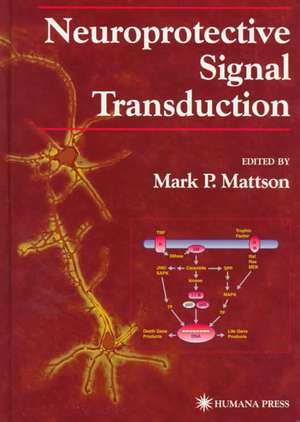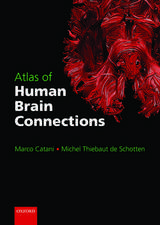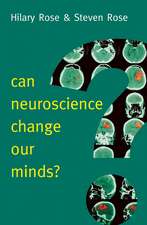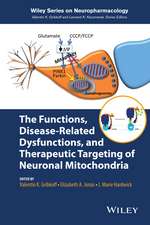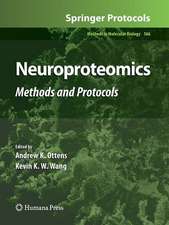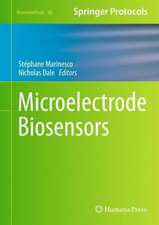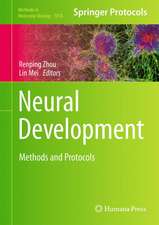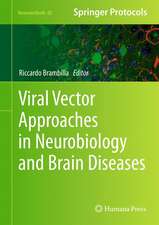Neuroprotective Signal Transduction: Contemporary Neuroscience
Editat de Mark P. Mattsonen Limba Engleză Hardback – 10 oct 1997
| Toate formatele și edițiile | Preț | Express |
|---|---|---|
| Paperback (1) | 1102.46 lei 6-8 săpt. | |
| Humana Press Inc. – 25 ian 2013 | 1102.46 lei 6-8 săpt. | |
| Hardback (1) | 1117.10 lei 6-8 săpt. | |
| Humana Press Inc. – 10 oct 1997 | 1117.10 lei 6-8 săpt. |
Din seria Contemporary Neuroscience
- 5%
 Preț: 1128.63 lei
Preț: 1128.63 lei - 18%
 Preț: 965.52 lei
Preț: 965.52 lei - 5%
 Preț: 1108.35 lei
Preț: 1108.35 lei - 18%
 Preț: 1228.15 lei
Preț: 1228.15 lei - 18%
 Preț: 1229.73 lei
Preț: 1229.73 lei - 18%
 Preț: 1231.64 lei
Preț: 1231.64 lei - 18%
 Preț: 945.47 lei
Preț: 945.47 lei - 18%
 Preț: 1244.08 lei
Preț: 1244.08 lei - 15%
 Preț: 638.76 lei
Preț: 638.76 lei - 18%
 Preț: 1240.47 lei
Preț: 1240.47 lei - 18%
 Preț: 1385.99 lei
Preț: 1385.99 lei - 18%
 Preț: 1227.84 lei
Preț: 1227.84 lei - 18%
 Preț: 1220.88 lei
Preț: 1220.88 lei - 18%
 Preț: 961.55 lei
Preț: 961.55 lei - 15%
 Preț: 695.70 lei
Preț: 695.70 lei - 18%
 Preț: 959.82 lei
Preț: 959.82 lei - 5%
 Preț: 1112.17 lei
Preț: 1112.17 lei - 18%
 Preț: 1233.83 lei
Preț: 1233.83 lei - 18%
 Preț: 950.96 lei
Preț: 950.96 lei - 24%
 Preț: 799.49 lei
Preț: 799.49 lei - 18%
 Preț: 954.77 lei
Preț: 954.77 lei - 18%
 Preț: 1227.21 lei
Preț: 1227.21 lei - 5%
 Preț: 1117.46 lei
Preț: 1117.46 lei - 18%
 Preț: 1248.02 lei
Preț: 1248.02 lei - 18%
 Preț: 949.10 lei
Preț: 949.10 lei - 5%
 Preț: 1114.35 lei
Preț: 1114.35 lei - 15%
 Preț: 694.22 lei
Preț: 694.22 lei - 18%
 Preț: 950.52 lei
Preț: 950.52 lei - 5%
 Preț: 1124.07 lei
Preț: 1124.07 lei - 24%
 Preț: 1089.43 lei
Preț: 1089.43 lei - 18%
 Preț: 1227.52 lei
Preț: 1227.52 lei - 18%
 Preț: 955.08 lei
Preț: 955.08 lei - 5%
 Preț: 1417.38 lei
Preț: 1417.38 lei
Preț: 1117.10 lei
Preț vechi: 1175.88 lei
-5% Nou
Puncte Express: 1676
Preț estimativ în valută:
213.75€ • 223.78$ • 176.87£
213.75€ • 223.78$ • 176.87£
Carte tipărită la comandă
Livrare economică 05-19 aprilie
Preluare comenzi: 021 569.72.76
Specificații
ISBN-13: 9780896034730
ISBN-10: 0896034739
Pagini: 347
Ilustrații: X, 347 p.
Dimensiuni: 178 x 254 x 26 mm
Greutate: 0.98 kg
Ediția:1998
Editura: Humana Press Inc.
Colecția Humana
Seria Contemporary Neuroscience
Locul publicării:Totowa, NJ, United States
ISBN-10: 0896034739
Pagini: 347
Ilustrații: X, 347 p.
Dimensiuni: 178 x 254 x 26 mm
Greutate: 0.98 kg
Ediția:1998
Editura: Humana Press Inc.
Colecția Humana
Seria Contemporary Neuroscience
Locul publicării:Totowa, NJ, United States
Public țintă
ResearchCuprins
Neuroprotective Strategies Involving the Neurotrophins and Their Signaling Pathways.- Nerve Growth Factor and Its Receptors in the Primate Forebrain.- Molecular Mechanisms of Neuroprotection from Neuronal Death by Trophic Factor Deprivation.- Gene Induction and Neuronal Apoptosis.- Clinical Potential of Compounds That Stimulate Nerve Growth Factor Production.- Preclinical Trials of Basic Fibroblast Growth Factor (bFGF) in Animal Models of Stroke.- Transforming Growth Factor-? Signaling and Neuroprotection.- Protective and Regenerative Properties of GDNF in the Central Nervous System.- Tumor Necrosis Factor.- Neuroprotective Strategies Based on Interleukin Signaling.- Signaling by ?-Amyloid Precursor Protein.- Clinical Potential of Agents That Affect Thrombin Signaling in Degenerative and Traumatic Neurologic Disorders.- Thrombin and Thrombin Inhibitors.- Deleterious and Salutary Effects of Steroid Hormones in the Nervous System.- Therapeutic Potential of Leukocyte Antiadhesion Strategies in CNS Ischemia.- Neuroprotective Strategies Based on Targeting of Postreceptor Signaling Events.
Textul de pe ultima copertă
In Neuroprotective Signal Transduction prominent researchers and clinicians focus on how inter- and intracellular signaling mechanisms prevent the degeneration and death of neurons occurring in both acute and chronic neurodegenerative disorders. Authoritative contributions dissect the signaling pathways of an array of neuroprotective factors-ranging from neurotrophins (NGF, BDNF, NT-3, and NT-4/5), to growth factors (bFGF, IGF-1, GDNF), to cytokines (TNF, IL-1b, and TGFb), to secreted amyloid precursor proteins, to protease nexin-1. Also treated are cytoprotective signaling events that occur within injured neurons independently of intercellular signals.
Neuroprotective Signal Transduction presents fundamental, cutting-edge treatment of the cellular and molecular signal transduction pathways found in human neurodegenerative conditions. The book's elucidation of the molecular cascades evolved by the nervous system to protect itself is now lead to effective strategies for preventing neuronal degeneration in such conditions as stroke, traumatic brain injury, Alzheimer's disease, Parkinson's disease, Huntington's disease, and amyotrophic lateral sclerosis, and will form the basis for powerful new drug discovery and gene therapy strategies.
Neuroprotective Signal Transduction presents fundamental, cutting-edge treatment of the cellular and molecular signal transduction pathways found in human neurodegenerative conditions. The book's elucidation of the molecular cascades evolved by the nervous system to protect itself is now lead to effective strategies for preventing neuronal degeneration in such conditions as stroke, traumatic brain injury, Alzheimer's disease, Parkinson's disease, Huntington's disease, and amyotrophic lateral sclerosis, and will form the basis for powerful new drug discovery and gene therapy strategies.
